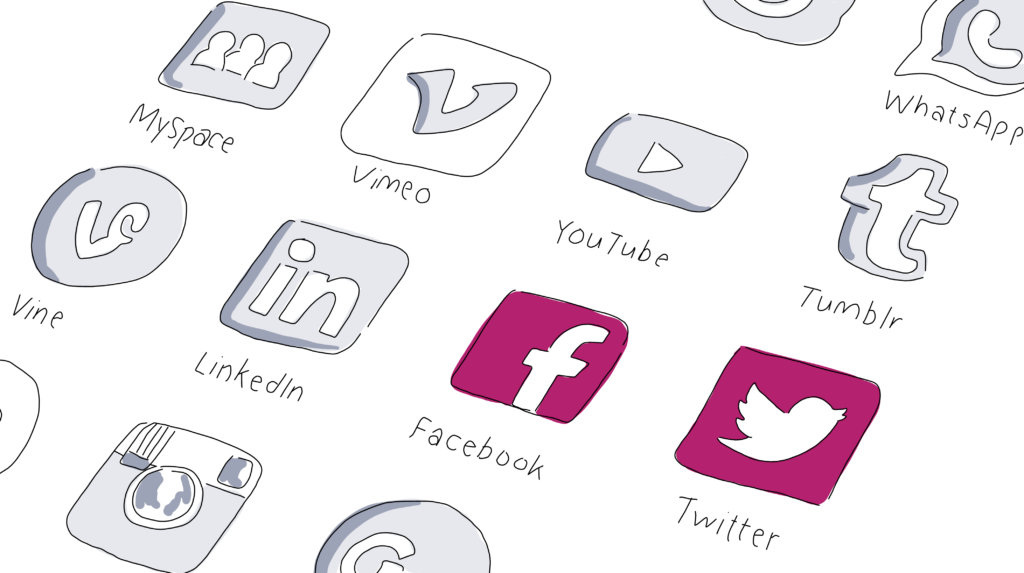
Social Media Strategy for Hotels: Why These Brands Rise Above the Rest
Now that social media strategy for hotels has gone from organic to pay to play, hotel brands are honing their social media strategy to get ahead of the game.
The most notable trend is matching the content to the platform rather than sharing the same content across channels.
See 10 Hotel Brands’ Social Media Strategies
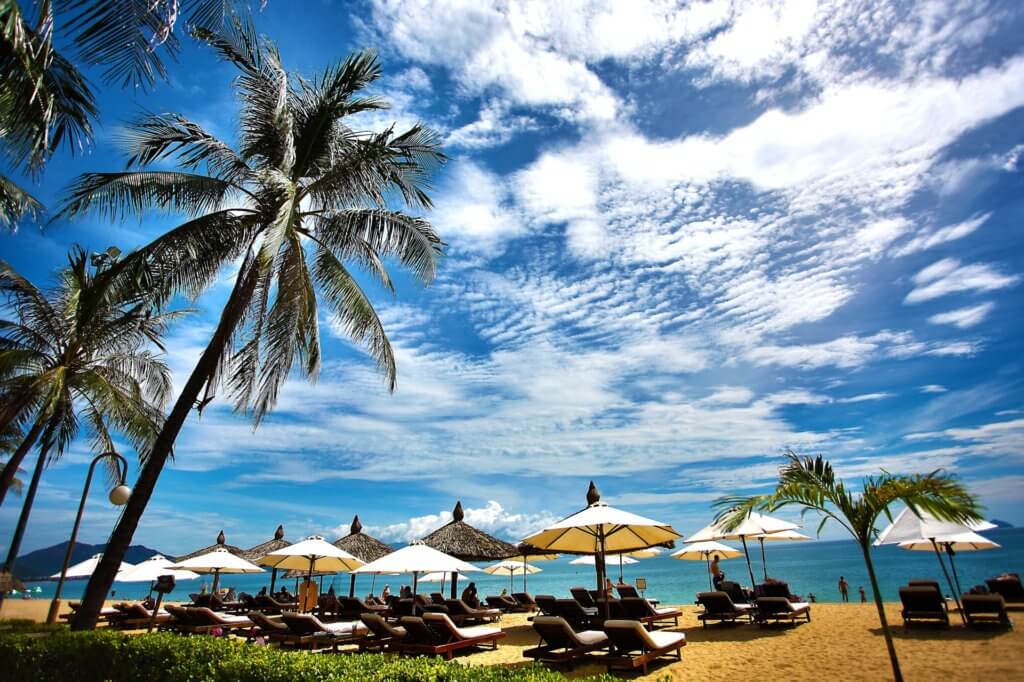
1. Hilton Hotels & Resorts
Hilton Hotels & Resorts is a luxury brand that has taken that ahh feeling out of the plush pillows of their rooms and delivered it in near virtual reality through their gifs, videos, and YouTube videos. It’s the same feeling of total relaxation but experienced in your office chair. However, the quality that makes Hilton really stand out is their ability to make dreams come true for employees as well as guests.
They do it by tapping into the history of their properties and taking a genuine interest in the humans they hire. By posting about real people, the hotel chain shows (not tell) their company value to travelers who then feel good about their choice to stay in accommodations that are both luxurious and philanthropic.
For example, Hilton has figured out that the worldview of travel and human connection has shifted. A recent Instagram post featured the heartwarming story of one former refuge turned Hilton employee whose journey is now being publicly honored by the brand. The video posted to their feed and Stories received at least 28 times their normal amount of comments. It also had the highest viewer count of any of their other video content.
[Tweet “The association of luxurious relaxation with Hilton will cement brand loyalty in its followers.”]
In general, the Hilton suite of social media accounts have the following characteristics that make them really unique and engaging:
Instagram:
The Hilton Instagram page isn’t just another property account – it’s branded as a newsroom. Representing all Hilton properties across the globe, this clever umbrella plays host to company milestone celebrations, glamour shots of properties, and a special kind of human-centric storytelling like we mentioned in the example above.
Twitter:
While there is some overlap with their other Instagram account, Hilton’s Twitter also shares reports on the latest travel industry software, new brand partnerships, and business articles that provide interesting takes on the modern traveler.
Facebook:
With over 120,000 likes, Hilton’s main Facebook page does a great job of going into topics under similar themes that you see on their other accounts, but they go into greater detail on this platform. By sharing longer, unique Facebook videos on these shared topics they bring a cohesive feel to their whole social media package while still honoring the social media marketing strategies that work the best, platform to platform.
LinkedIn:
Their page has almost 900,000 followers and features history, news, and content that most appeals to their B2B audience as well as business travelers.
YouTube:
Although they post original content less frequently on this platform than others, Hilton does a great job of showcasing commercials that have aired elsewhere along with fresh advertisements like the enticing Vacation Time and The World is Right Here series.
2. Marriott Hotels & Resorts
2019 welcomes Marriott’s rebranded loyalty program: Bonvoy. They’re so invested in it they’ve actually changed all their official URLs, username handles, and even their company name to Marriott Bonvoy. The update includes better rewards point conversions, exclusive members-only accommodations, one-of-a-kind experiences, opportunities for elite members to earn double points, an app, and a fresh social media marketing campaign to spread the word.
Right now, the brand spends the most time promoting individual portions of the loyalty program that appeal to audiences on each individual social media page. For example, their Double Take campaign focuses on the opportunities for doubling rewards points through the use of Facebook video.
Each branded piece of content features upbeat music with images of their properties and text overlays that note the key selling points for the program. Clocking in at less than 20 seconds each, these videos are an excellent example of how other brands can effectively advertise their latest customer experience offerings.
Instagram:
Marriott does a great job interacting with their audience. In this Instagram post (which received nearly 8,000 likes and more than 40 comments), Marriott shares answers to cute questions they’ve asked their audience like what practices (i.e. things Marriott has done for them during their stay) have you brought home from your travels?
Twitter:
Besides promoting their loyalty program, Marriott makes sure to retweet every post that their guests share about how wonderful their experience at their hotel was.
Facebook:
We’ve already mentioned their great videos, but you can also find unique posts (highlighting things like their new villas and home rental program) being enjoyed by over 3.6 million followers.
LinkedIn:
They’ve made their LinkedIn a great resource for current and future employees by sharing articles on topics like how to develop your own personal brand. They also offer incredibly creative videos celebrating employees at every level (this week’s video was of a Marriott doorman) who give their best tips and insights into doing their jobs well. As far as we can tell, this original content is exclusive to the LinkedIn side of their social media efforts.
YouTube:
With more than 17,000 subscribers, Marriott is one hotel brand that knows how to flex YouTube right. They’re highly organized and descriptive playlists are a huge draw, featuring videos about what’s new at Marriott and their original reality show, Hotel Countdown, which takes viewers behind the scenes of hotel openings.
3. Ramada Hotels
Ramada Hotel’s social content is engaging. And not just generically engaging “ it’s fun, it makes you want more, and it’s useful with content like emerging travel news to micro-moment games to capture your attention. Ramada’s posts make you stop scrolling through your feed because you have to check out what they’re doing right now. They really are using social media strategy for hotels to their advantage.
One post, in particular, found on the company’s Facebook page, gives their fans a first-hand perspective on Belfast. The 16-second long video is so enticing that it is one of their most shared posts! It’s one of many featured in their Say Hello to Travel campaign that showcases cool places and events happening all over the world, which makes perfect fuel for travel enthusiasts who are more likely to share the posts anyways.
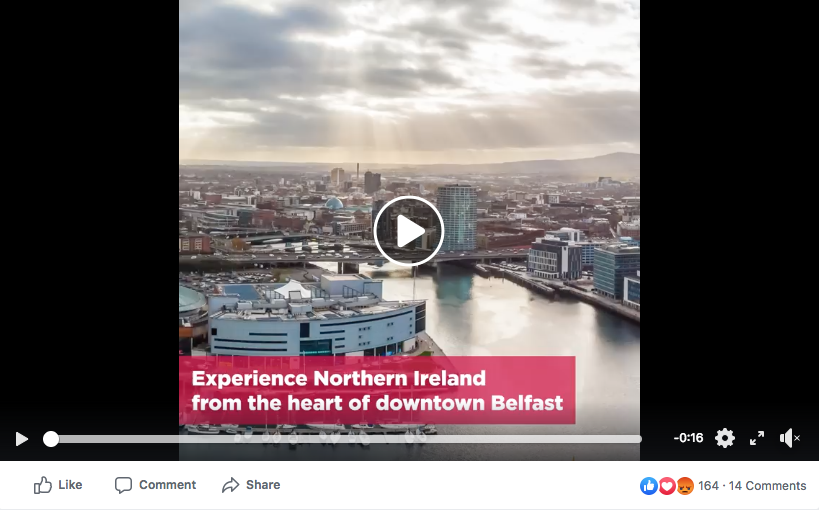
Instagram:
Rather than have an individual Ramada Worldwide account, the brand uses #ramada to unify their various properties and bring fan appreciation posts all to one page.
Twitter:
In keeping with their fun-loving attitude, some of Ramada’s most popular tweets include “guess the skyline,” where fans can name a city where a Ramada hotel is located based on the graphic. They also provide helpful travel tips regarding passports, avoiding delays, and private travel trends.
Facebook:
The strongest (read: most followers) of their two active social media channels, the Ramada Facebook page is a go-to for those struck by wanderlust gather for videos (like the Belfast example above), as well as glamorous off-property shots. For Ramada, it’s all about showcasing the best part of travel: the destination.
LinkedIn:
Similar to their Instagram strategy, Ramada concentrates on individual locations but the brand as a whole doesn’t have its own page. However, they do have a Group called Ramada Worldwide that is only accessible if you’re accepted to join.
YouTube:
Since they largely concentrate on Facebook and Twitter, the Ramada Worldwide YouTube page is woefully neglected (although you can still find some high-quality original videos and commercials). However, focusing their efforts on just two of the major platforms is a good strategy for hotels just getting their social media strategy together or for boutique properties with limited marketing resources.
[Tweet “Ramada’s posts make you stop scrolling your feed to check out what they’re doing right now.”]

4. Loews Hotels
Marketers know that one of the top trends in digital marketing right now is authenticity. Loews has more than got that covered. Not only are these campaigns leveraging authenticity generated by real guests, they’re making it fun for everyone.
They use a lot of the best social media marketing for hotels, but one of the best examples of their work has to be their clever use of Instagram Highlights.
A recent creation from the Loews Hotels marketing team, the Travel Tuesdays saved stories feature a rotating cast of beloved destinations displayed like a virtual scrapbook. Viewers learn about popular tourist attractions along with local trivia and special offers from the brand. It’s informative, whimsical, and well-designed – what’s not to love?
Instagram:
A gorgeous mix of lifestyle photos and shots of models (who look like they could be real customers at Loews Hotels) has won their account over 25k followers.
Twitter:
Loews Hotels understand how important it is to be playful yet still advertise the perks that make them so unique.
Facebook:
This hotel brand isn’t afraid to spread the love by sharing some of their best performing content on both their Twitter and Facebook page. But they do have exclusive content like blog posts and inspiring pictures featuring philosophical quotes that make you stop and think.
LinkedIn:
Loews does well across the board but their LinkedIn, in particular, boasts over 40k fans, which is better than some other top performers on this list. They focus their channel efforts on company news updates and job postings. But they also use this space to help showcase their core business values, namely family-first and personal growth.
YouTube:
Destination guides, press updates, and glossy videos of the Loews Hotels’ brand vibe are enjoyed by thousands of fans on their account. It’s important to note that they update their account frequently enough (at minimum once a quarter) to keep people engaged but they also prioritize evergreen content, giving their page more staying power than most other hotel brands.
5. RIU Hotels & Resorts
RIU, as a brand, is killing it across all social media platforms. Despite have a huge following, they always take the time to answer comments and questions. And their answers aren’t canned responses either – they’re thoughtful, personal, and appreciative (virtually no answer is without a genuine thank you message at the end).
This level of commitment to social media interaction is most likely what has won over the majority of their audience – everyone loves spending time on friendly, personable accounts. Overall, RIU’s main social media marketing strategy for hotels seems to be, “kill them with kindness.”
In addition to portraying such a positive brand image, RIU also knows how to sell their properties. Although the Maldives is already a gorgeous location, RIU still manages to showcase this popular tourist destination in a way that sets them apart from others like it: strategic partnerships. One of their more recent IGTV videos features a very popular video an NFL cheerleading squad modeling and enjoying their stay at the resort. It’s unique, fun, and definitely persuasive.
Instagram:
Besides gorgeous models playing volleyball, the RIU’s Instagram also has pics of their glamorous properties and the occasional contest (which nabs them thousands of comments and likes per post).
Twitter:
The bilingual account posts in English and Spanish – a refreshing addition to other international hotel chains that limit their language usage to just English.
Facebook:
RIU Hotels posts generous discount codes on rooms and experiences exclusively via their Facebook page, so fans know to check back frequently next time they plan their vacation. Even if there isn’t an active code to be found, viewers can browse breath-taking video tours and photos of their locations (all of which have a minimum of two comments from previous guests saying how much they loved their stay there)!
LinkedIn:
RIU has an amazing 70k+ followers on their LinkedIn page. What makes their fans love them so much? A mix of environmentally conscious consumer tourism info posts and bilingual company updates for starters.
YouTube:
Their most popular videos include a fun peek at their special events packages (like Bachelor and Bachelorette getaways) and a scenic view of NYC from one of their properties. They even included a prize drawing in the video description!
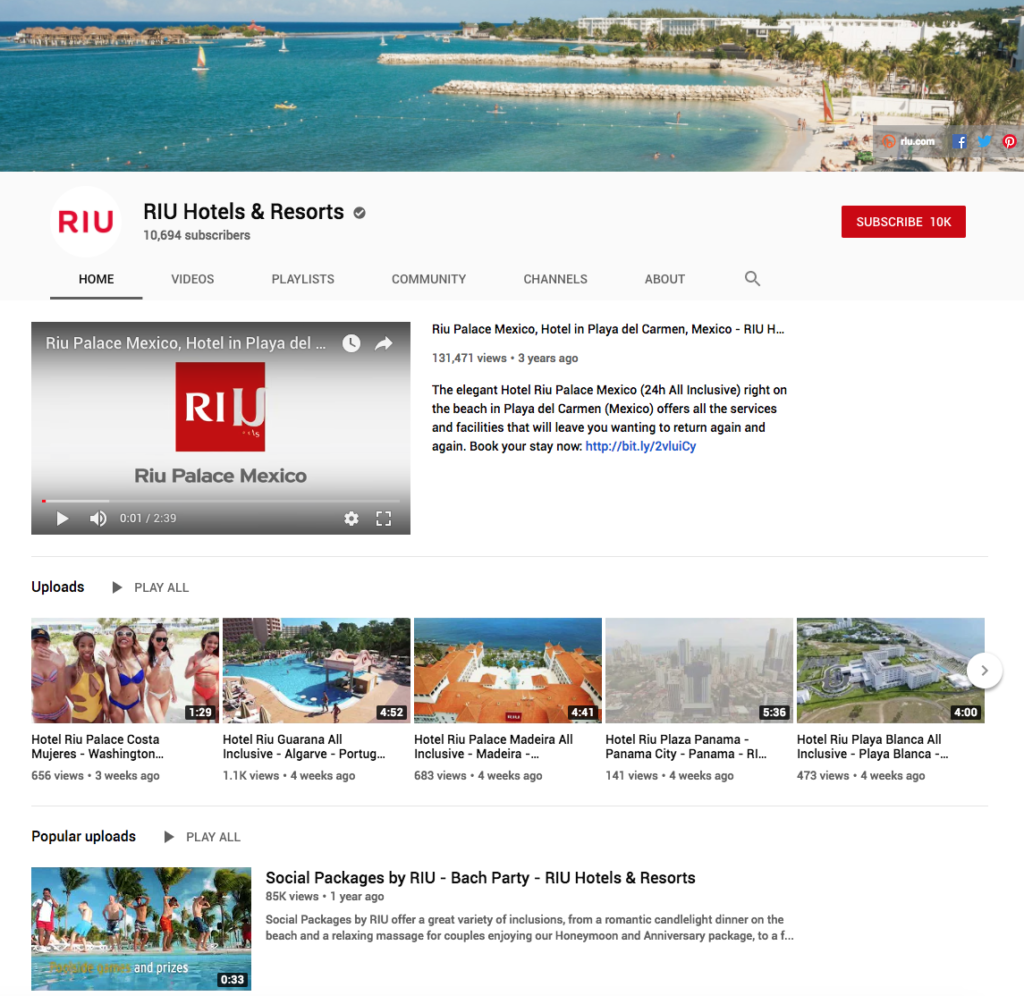
6. Four Seasons Hotels and Resorts
The Four Seasons has a clear strategic direction for their social media marketing: luxury and affluence. It’s something they’ve been known for in the industry and it works just as well as a foundation for their marketing. At their core, they are a luxury hotel chain with impeccable customer service and a deep understanding of how to integrate the latest software and technologies into their daily practice.
The brand has the most followers (coming close to million on some platforms) of almost any other hotel chain on every social media channel, so it’s hard to choose which of their posts are the best since they all work in harmony together to create a cohesive viewer experience. From expertly composed photography to shameless puppy and kitten models, the Four Seasons Hotels and Resorts social media package has everything a potential guest could want.
They’re also great at turning out a high volume of social media content consistently, which is probably why they’ve managed to maintain such high audience numbers despite sharing duplicate content across all platforms. For example, they post something to their feed at least once every day on Instagram, Twitter, and Facebook.
Instagram:
The brand takes care to appeal to a global audience without being too generic. Because wellness is important to their affluent consumer base, they ran a campaign leading up to Global Wellness Day that showcased their brand values through IG live videos and photos describing the many ways guests of the Four Seasons can live happier, healthier lives just by staying at their properties.
Twitter:
If you tweet or mention their account, you will always get a response. Which may not seem like that big of a deal until you consider the fact that they have 268k followers and still manage to reply the same day. It’s a smart social media marketing strategy for hotels but it’s also an active demonstration of their exceptional customer service. If customers can’t rely on the brand to help them online, how can they count on them in person during their stay?
Facebook:
There’s no doubt about it – the Four Seasons is using their Facebook page to its fullest since its inception in 2009. They’ve integrated their Pinterest and Instagram to the platform. They even actively use their Jobs section for hiring on new, talented employees and showcase their biggest ticket item on their services menu (wedding venues and related services) in a section all by itself, so guests can get inspiration for their big day when looking for places to book ceremonies and/or receptions.
LinkedIn:
Because The Four Seasons is such a big believer in helping guests and fans achieve their potential, it makes sense why their LinkedIn page features tips on interviewing for jobs. They also do a great job of showcasing the expertise of their own employees – everyone from their Pastry Sous Chef to their Director of People and Culture shares stories and wisdom. Despite sharing many posts across all their channels, this series is exclusive to LinkedIn.
YouTube:
Their YouTube is by far the best example of social media marketing for hotels. They have way more playlists than any other brand, on topics like personal storytelling, living mindfully, one-of-a-kind globetrotting experiences that are almost exclusively available to Four Seasons guests.
7. Hotel Punta Tragara & Spa
This single property luxury hotel in Italy has the perks of being in a well-traveled location. But more than that, they use social media strategy that is just as high quality as their seaside villas. Their minimalist modern interiors are sleek and attract hordes of Instagram fans, but so do the gorgeous penthouses of their competitors.
So, how does Hotel Punta Tragara & Spa stand out, exactly?
Hotel Punta Tragara & Spa is another smart luxury hotel brand that understands how to focus their efforts on their highest performing social media accounts. To this end, you’ll see a lot more posts and engagement across their Instagram and Facebook pages than any other medium. And their fans have greatly rewarded them for it with 79.3k and 24k followers, respectively.
As far as the social media content itself, we see Hotel Punta Tragara really knows how to give their fans the experience of being there through teaser videos and photos that make you feel like you can just step right in them, Alice in Wonderland style.
For example, this short video (taken by a guest but shared by the brand’s main account) shows a tub running water to draw a bath overlooking a gorgeous cliffside ocean view. It continues to show the master suite, walking through as if in first person perspective, giving viewers the sense that they could easily have a video like this on their own phones to make their friends jealous when they visit and stay at Hotel Punta Tragara themselves.
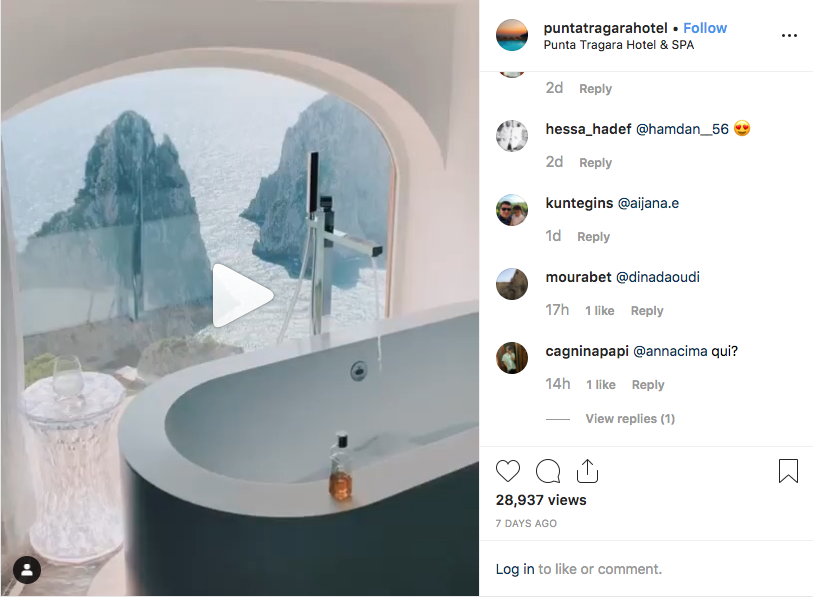
Instagram:
The strongest of all their social media accounts, Hotel Punta Tragara & Spa took a risk by putting all their chips in this basket–and it has paid off exponentially. All of the photos as super shareable thanks to bright, cheerful colors and smart presentations that give you that magical quality of teleporting to the scene itself. Their account overall is incredibly organized and professional, as evidenced by the uniform saved Stories covers.
Twitter:
Like we mentioned before, this luxury hotel brand sticks to their tried and true social media avenues and do not, in fact, have a Twitter account of their own. However as you can see from the linked search results, they don’t really need to. Fans are constantly tweeting their vacation photos and videos, thanking the property for a wonderful stay. They’ve also been featured on many travel accounts, so the word has spread pretty quickly without their having to create content on the platform.
Facebook:
Facebook is their second most used social media platform, mostly because they seem to take advantage of the customer service aspects of the site as well as the events feature. One of the key social media marketing for hotels tactic that they employ on this account is tailoring the content to fit the platform. Yes, they do share their most popular Instagram posts here too. But Facebook is the only place you can learn about Hotel Punta Tragara’s awesome concerts, read the 300+ reviews from actual visitors (they’ve got 4.7 out of 5 stars), and speak directly with customer service for any booking questions.
LinkedIn:
While they do have some following on LinkedIn, it’s clear that their purpose for creating a profile here is very specific. The description is in Italian, they’ve made sure to list their 33 executive employees, and their contact information is clearly laid out. They have not created any original posts, which lets us in on their goals: appealing to personal versus business travelers while maintaining the necessities of a LinkedIn page that is strictly for interacting with their own network.
YouTube:
Just like their Twitter account situation, the Hotel Tragara is so popular it has amassed thousands of search results from top travel blogs and brands, showing off their own guides of the breathtaking property. Why create original content when your fans are already doing it for you? While we don’t advise this strategy for everyone, it’s a good lesson in understanding where your brand name is already strong and hyper-focusing efforts on your highest ROI marketing activities.
8. Amilla Fushi, Maldives
Amilla Fushi is yet another hotel brand that understands how to play to their strengths. Their #IslandBliss campaign looks and feels like a dream come true. They make sure to tag #YourIslandHome on any property or room photos, which gives the experience a personalized feel as fans can easily imagine themselves lounging on their private beach chairs.
They also do a great job of showcasing experiences (which is yet another hashtag under their main campaign). Getting your audience to see how your hotel fits into their entire vacation or travel itinerary helps make even the most expensive rooms seem reasonable when you consider all there is to do once you arrive.
For example, this post features a highly regarded Maldivian artist playing his original music for guests, one of the #RichExperiences that can only be had if you stay at Amilla Fushi.
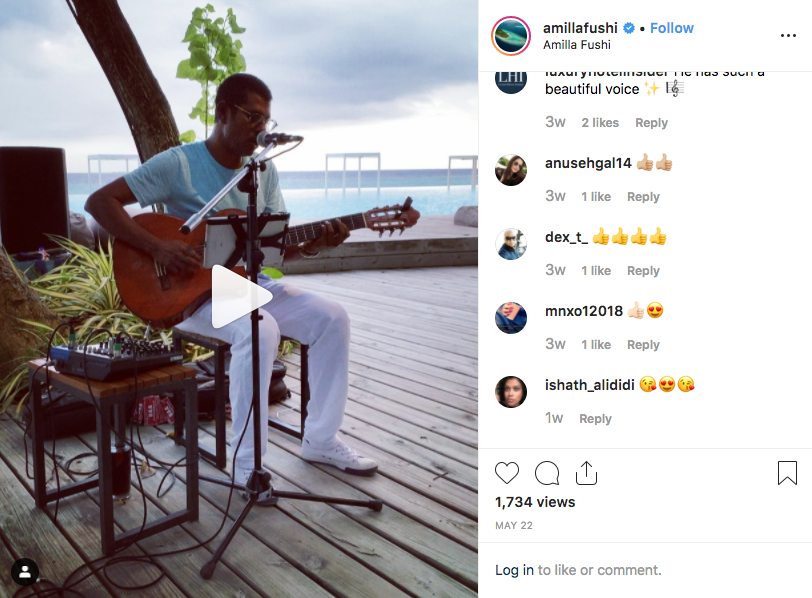
Instagram:
They have an impressive 109k followers and share photos of the property along with scenes from daily life at the hotel that showcases a comprehensive picture of what guests can look forward to when they visit.
Twitter:
Amilla Fushi is consistent, tweeting at least once per day. Their content is a mix of wanderlust photos, calls to action, and fun activities like watersports or beachside bicycle rides.
Facebook:
Their videos section is the most interesting part of Amilla Fushi’s page. On it, you’ll see a number of highly produced videos covering local festivals, special events, property tours that are exclusive to this corner of the internet.
LinkedIn:
Admittedly, Amilla Fushi’s presence on LinkedIn is close to nonexistent. But again, being a business-centric social media platform primarily used by people in the U.S., China, and India, this could illustrate how Amilla Fushi’s team understands the needs of their target audience, who may not care to have engagement with the brand via LinkedIn after all.
YouTube:
Their YouTube presence is a lot more recent than their other social media accounts, but Amilla Fushi has been doing a great job at consistently posting original content at a pace of about 2 videos per month. Not only is their post volume consistent, but they also keep their content at or below 5 minutes and limit their topics to hotel specific events and tours.
This kind of all around consistency is a surefire way to nearly guarantee audience growth on YouTube over time. Viewers know what to expect and when to expect it, which is a great way to conduct social media marketing for hotels no matter what your goals are.
9. Le Sirenuse
An award-winning, family-run luxury hotel, Le Sirenuse is truly a gem of Positano, with the social media to prove it. The 18th-century villa itself is beautiful and every nook and cranny of the property is shown throughout their various online profiles. What makes them really stand out though is the thoughtfulness of their text.
Their posts feel more like mini diary entries than advertisements (although they certainly do a great job of drawing in digital crowds). For example, one of their most recent tweets lets their audience in on the fact that Positano will soon be crowded with tourists, but its offseason views are just as – if not more – spectacular.
Instagram:
Cohesive color schemes, creative composition, and whimsical subjects make up the bulk of the photography you’ll find on this account. Overall, it’s a truly enviable set of images. The trick is they use is to take photos that look great individually but also work together to tell a larger story. You’ll often see details of palm fronds or textured structural domes next to airy skyline panoramas. Playing with contrast and clever photo placement is a great social media marketing strategy for hotels, regardless of where you’re located or how much photography experience your team has.
Twitter:
Written content is one of their greatest marketing strengths and their Twitter profile archives some fantastic examples of posts that, like in the example above, really set them apart from competitors. Thoughtful, familiar, and informative, each new piece helps shape the brand image as a whole.
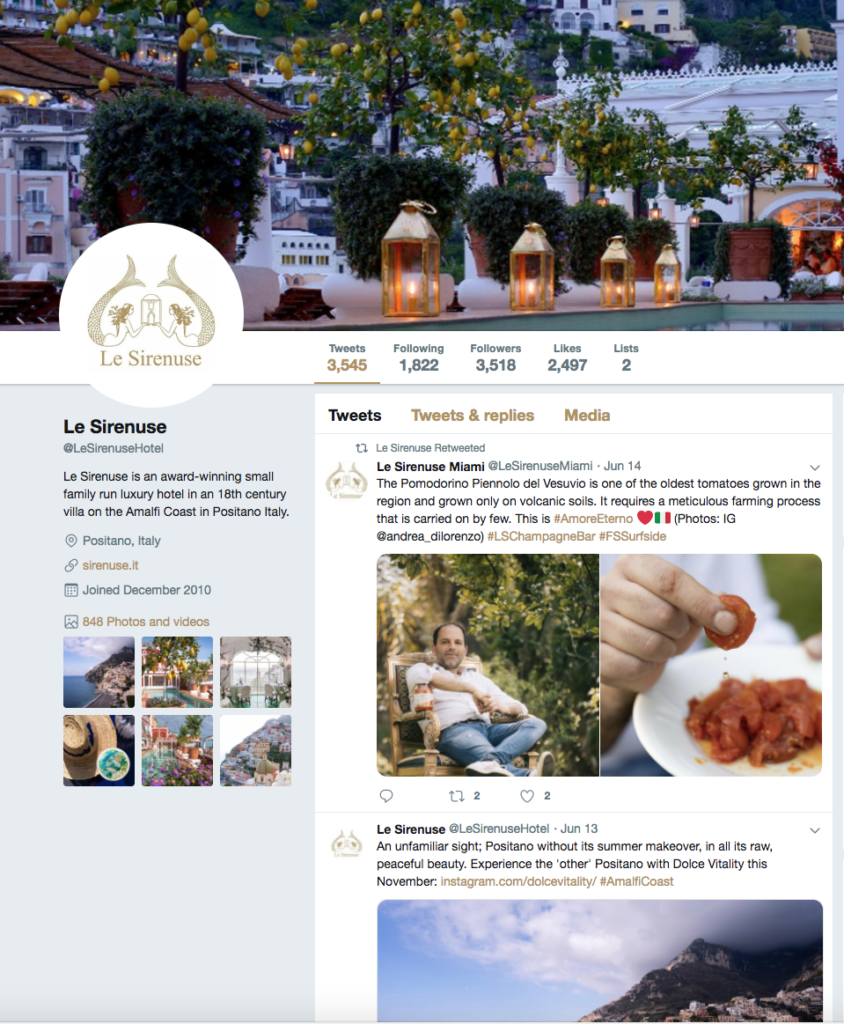
Facebook:
35k followers just can’t be wrong – Le Sirenuse is certainly doing something right when it comes to social media marketing for hotels. Fans are treated to videos of breakfast overlooking the view of Positano and lovely slice-of-life photos with descriptions that are just to die for.
LinkedIn:
While some employees list themselves on the site, the brand doesn’t have a LinkedIn presence.
YouTube:
Yet another example of having a property so amazing your fans can’t stop raving about it online. A quick YouTube search for the hotel yields pages of results with each video achieving anywhere from 3.3k to 161k views! A lot of the footage featured in the videos are firsthand from bloggers, but there are also professional drone movies and other highly produced content that is so beautiful any marketer would be pleased to have it. Whether or not the brand is partnering with these influencers and professional content creators is unclear. However, if they are, it’s certainly paying off.
10. Millstone Cave Suites
Millstone Cave Suites is famous for its killer views of hot air balloon festivals lazily drifting over the Red Valley. But how do they draw crowds during the off season? By using great social media marketing for hotels, that’s how. In addition to promoting their hotel, Millstone Cave Suites also heavily features their onsite restaurant with videos of gourmet meals being artfully prepared.
What we love about this example is that, in less than 30 seconds, you get a sense of everything that makes Millstone Cave Suites a must for your travel accommodations. Their own personal farm with roosters crowing at daybreak adds a quaint, country feel to the experience. The dreamy rock music on top of the video is hipster, fun, and a touch ethereal – all words you can use to describe the brand itself.
Plus, the main attraction (a gorgeous outdoor smorgasbord of breakfast foods prepared fresh by expert chefs) is a total knockout and can easily be used as a template for brands looking to create winning social media content of their own.
Instagram:
Gorgeous mountain views of hot air balloons and fine dining are perfect for this platform, which is probably why Millstone Cave Suites now boasts 63k followers with strong engagement numbers (232k views on a video posted to their feed is not uncommon).
Twitter:
Instagram is going so well for them that the brand has opted out of tweeting entirely. But luckily for Millstone Cave Suites, accounts like Billionaires and Experience the World are already reaching their target audiences for them.
Facebook:
Fantastic video content and recommendations are the key features of this page. They also use this space to promote their achievements (like TripAdvisor’s Certificate of Excellence) and PR (they recently won a right up as a top 5 destination by GQ).
LinkedIn:
In what has become a theme for our single location international hotels, their LinkedIn presence is also nonexistent. Although with 4.9 out of 5-star reviews on Facebook and a dedicated audience everywhere else, they don’t seem to be missing out.
YouTube:
Despite being one of the best video creators out of this list, they don’t seem to invest too much into their YouTube page. For brands kicking butt at video, there’s no shame in cross-promoting your content on this popular platform, even if there’s some overlap. But again, their guests are happy to leave their own video tours because they love the hotel that much.
Next Steps in Social Media Marketing for Hotels
What is social media strategy for hotels doing for you? These four hotel brands have invested time and care in figuring out when and why their followers use a particular platform.
They give the audience what it wants in the right time and place, and engagements grow out of that naturally. Check them out and see how you can breathe new life into your own strategy.
Up next, discover top hotel marketing ideas and try event venue software that makes it easy to show off your space on social media and throughout your digital web presence.
Social media strategy for hotels is a powerful tool in the hospitality industry. So tell us: how has social media given your hotel an advantage? Join us on Facebook or LinkedIn to let us know.


